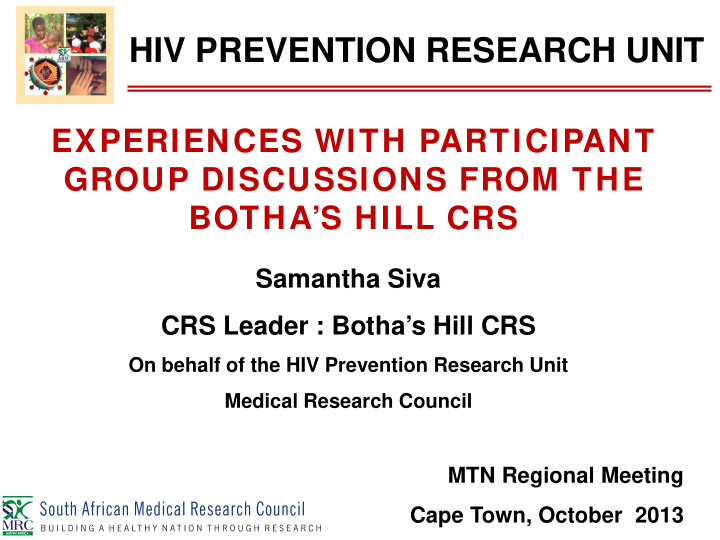



HIV PREVENTION RESEARCH UNIT EXPERIENCES WITH PARTICIPANT GROUP DISCUSSIONS FROM THE BOTHA’S HILL CRS Samantha Siva CRS Leader : Botha’s Hill CRS On behalf of the HIV Prevention Research Unit Medical Research Council MTN Regional Meeting Cape Town, October 2013
INTRODUCTION Group discussions are held daily in the waiting area of the CRS. Purpose of group discussions : o Facilitate open, honest discussions amongst participants and staff. o Good forum to share knowledge and information on general health issues and for staff to share certain key messages with participants (e.g. adherence, retention) as well as to address misconceptions. o Facilitates a good relationship between staff and participants (builds rapport) and encourages honest reporting of issues.
INTRODUCTION Discussions are conducted throughout the day, not just in the morning. Initially facilitated by staff – moved to facilitation by participants. Roster developed so that all staff members are involved in group discussions. Participants therefore do not hear the same message from the same person all the time. Each group includes a nurse, pharmacist, counsellor and member of the community team. Peer educators are sometimes requested to facilitate these group discussions. Topics discussed include adherence and retention as well as general health related topics.
GROUP DISCUSSION PROCESS Participants are asked to suggest topics that they would like to discuss. Interaction is encouraged and participants eventually take over the discussion with minimal input from staff. Participants are encouraged to share experiences and they are assured that their suggestions/thoughts will be given consideration. Those who may not be comfortable to share with the group are encouraged to share during their one-on-one sessions with the counsellors or write down their thoughts and place them in the suggestion box.
TOPICS FOR DISCUSSION Examples of topics discussed : o Importance of the ASPIRE trial and why a female initiated HIV prevention tool is needed. o Adherence o Contraception o STI/RTI and treatment o HIV/AIDS treatment including side effects o HIV Preventative Measures o General Health Care
HIV RIBBON ACTIVITY The HIV ribbon activity is also carried out. Participants are given an HIV ribbon to write down their motivation for participating in an HIV prevention trial.
OUTCOME OF GROUP DISCUSSION Group discussions have been beneficial to both staff and participants for the following reasons : Participants have built a good relationship with staff and each other – this allows more open and honest reporting of issues to staff. It also means that participants can support each other with study related issues. The discussions are beneficial as participants learn strategies from each other regarding how to handle certain situations with their partners with regard to ring adherence.
OUTCOME OF GROUP DISCUSSION Some participants have reported that even if their partners are not happy about them wearing the ring, they still do: (quote) “ we won’t risk our lives by removing it ”. These participants are instrumental in dealing with adherence issues as their bravery encourages others. Myths and misconceptions are dispelled during these sessions. Participants report that these educational talks also help the older generation to be well informed about health in general and they are then able to teach the younger generation about these health related issues.
ANECDOTES When participants share their stories, they have an effect on each other and some may change the way they think or see things. Participant A “I have a 13 year old daughter who, sooner or later, will be engaging in sexual intercourse and if I “I want to be proud of adhere to the ring maybe it myself one day when the will be successful and by ring is approved. I want to the time my daughter may be able to tell people that I be exposed to HIV, was part of the group that hopefully the ring will be on found an HIV prevention the shelves already”. method because this is a disease that has taken the lives of so many people that Participant B I know”.
ANECDOTES Participant C “I did not disclose my study participation to my partner. When I decided to disclose to “Lets all use the him at a later stage, he ring because if asked me to remove the MRC staff are ring but I told him that speaking to us only the doctor at the about using the clinic could insert and ring then it must remove the ring”. be important”. Participant D
ANECDOTES “We want to participate Participant E in the study to change peoples lives and also to be a part of the HIV prevention team”. “I was afraid to tell my partner about the study and ring use and wanted study staff to assist me “We feel fear and with disclosing this concern for our information. Staff children as they grow explained the study to my up in a world in which partner and he understood HIV is rife”. and we don’t have any issues now”.
LESSONS LEARNED Participant centered approach The discussions were initially structured and led by staff and were not too o interactive. This was changed to allow participants to facilitate discussions and decide on topics – discussions are much more interactive and participants feel that they are contributing and learning at the same time. Increase Frequency of Group Discussions per day Group discussion would initially take place in the morning, with the o participants who arrived early. Participants who arrived late, would sometimes not be present for the group discussion. Decided to conduct education sessions more than once a day – whenever there is a group of participants seated in the waiting room. Variation in discussion topics Because topics are suggested by participants, the same information is not o discussed at every group discussion – participants who may be present for more than 1 session in a day are therefore not hearing the same messages repeatedly.
Thank You
Recommend
More recommend